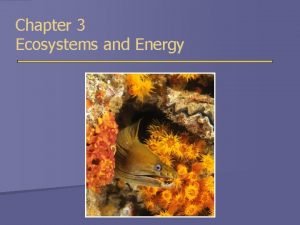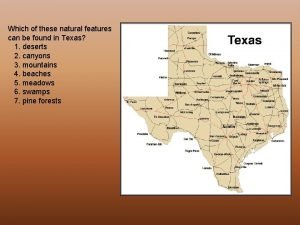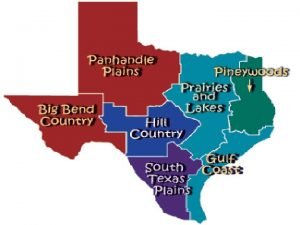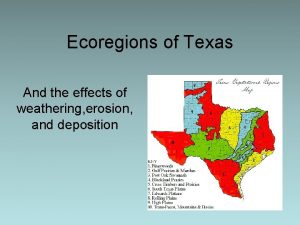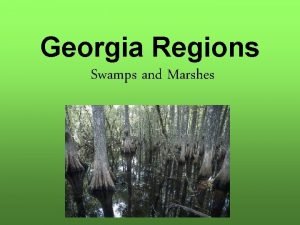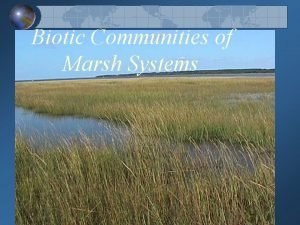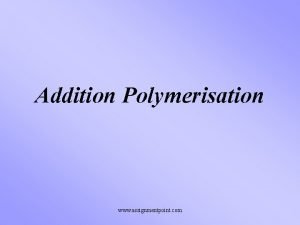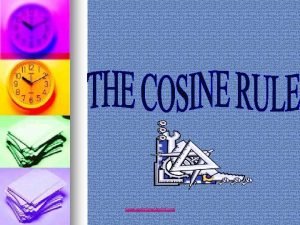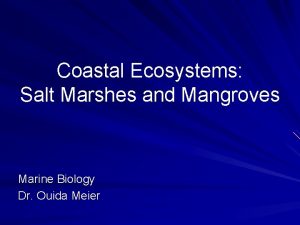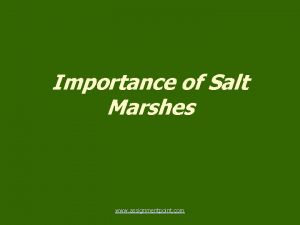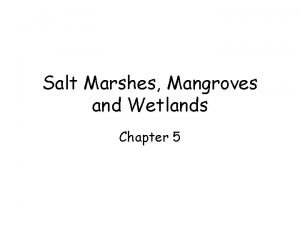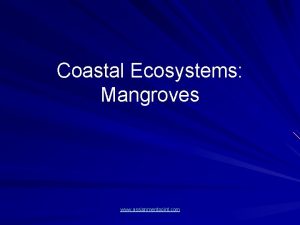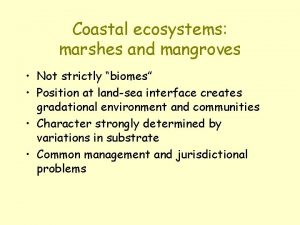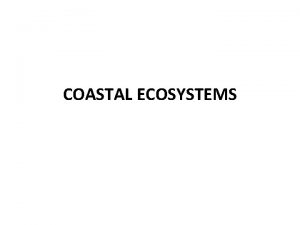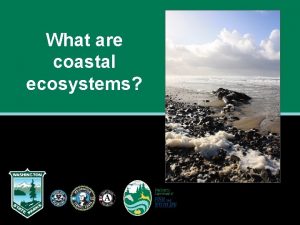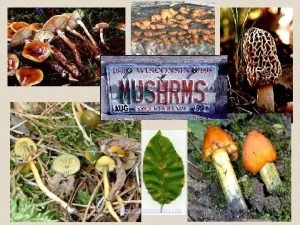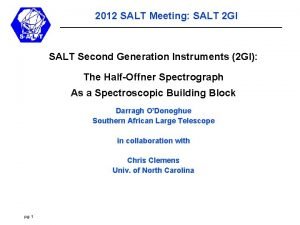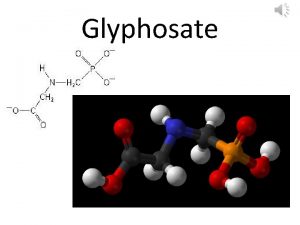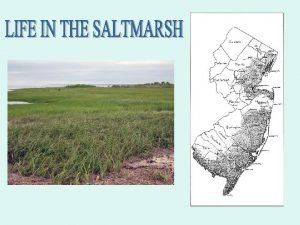Coastal Ecosystems Salt Marshes www assignmentpoint com Factors













- Slides: 13

Coastal Ecosystems: Salt Marshes www. assignmentpoint. com

Factors Driving Coastal Ecosystems Latitude – temperature – light, seasonality Tidal cycles – amplitude – frequency Wave energy Degree of riverine input – freshwater input – alluvial sediments and deposition – turbidity www. assignmentpoint. com

Factors Driving Coastal Ecosystems (cont. ) Geological characteristics – – – rock sand sediment Hydrological characteristics – nearshore currents – transport Continental proximity – nutrient input – anthropogenic impacts www. assignmentpoint. com

Recap: Rocky Intertidal Our example (Pacific Northwest): high latitude, so Cold Pacific waters, strong seasonality Tidal cycle: high amplitude, semi-diurnal Wave energy high Freshwater input – riverine characteristics modified by bay / estuary Geology: rocky cliffs, interspersed w/sandy beach Hydrology: strong nearshore currents & transport Continental edge, input via interaction with terrestrial systems www. assignmentpoint. com

Salt Marsh Ecosystems Our example (southeastern U. S. : Gulf and Atlantic coasts): moderate latitude, so “Warm” Atlantic and warmer Gulf and Gulf stream waters, moderated seasonality Tidal cycle: low amplitude Wave energy low Freshwater input often critical – deltaic riverine input can result in extensive marsh systems, abundant alluvial sediment input. Salt accumulation a challenge. Geology: long-term alluvial sediment accumulation Hydrology: nearshore currents & transport important Continental edge, nutrient input via runoff, rivers www. assignmentpoint. com

Salt marsh and tidal channels in coastal Georgia www. assignmentpoint. com

Plants of the Salt Marsh Community Spartina alterniflora – marsh cordgrass – height depends on riverine or tidal flushing – export of dried mats during winter storms – exclude salt from roots Salicornia – a succulent – Salt pans Fresher water and soils / higher ground: other grasses (Spartina patens), rushes (Juncus romerianus), sedges Zonation based on topography, inundation of freshwater, fresh/salt fluctuation, tidal flushing, relative stresses, anoxia of soils, latitudinal gradient (e. g. , east coast U. S. ). www. assignmentpoint. com

Salt marsh replanted afterwww. assignmentpoint. com a break in an oil pipeline

Animals of the Salt Marsh Community Geukensia demissa – dominant mussel – lives in sediment – physiological variation with tidal cycles Crassostrea virginica – oyster – dense beds in well-flushed tidal channels Littorina irrorata – salt marsh snails; pulmonates Thais haemostoma – oyster drill Uca pugnax, other Uca spp. – fiddler crabs Sesarma cinereum - marsh crabs (These examples are particularly for south Louisiana and coastal Georgia; other species will occur elsewhere, filling slightly modified niches depending upon range, region, www. assignmentpoint. com and local conditions. )

www. assignmentpoint. com An herbivore in the salt marsh community

Salt Marsh Communities: Highly productive Very stressful Trap sediment Stabilize and extend coastlines, especially those with fluvial input Food webs detritus-based; herbivory may be more important than previously thought; “trophic relays” convey biomass to adjacent ecosystems Low diversity, high productivity www. assignmentpoint. com

Wetlands Loss: Salt Marshes Coastal erosion and wetland loss due to channelization and levees along the Mississippi, dams on its tributaries, land settling from groundwater pumping and use, and channels cut through the marsh for offshore drilling platforms. Estimates of Louisiana coastal wetland loss for 1978 -90 indicate a loss of about 35 square miles a year of freshwater and non-freshwater marshes and forested and scrub-shrub wetlands. From 1978 -90, that equalled a 12 year loss of about 420 square miles, an area twice the size of the populated greater New Orleans area. http: //www. lacoast. gov/news/press/1997 -10 -27. htm http: //www. tulane. edu/~bfleury/envirobio/saltmarsh. html http: //www. bonitanews. com/03/10/naples/e 1631 a. htm www. assignmentpoint. com

www. assignmentpoint. com Example of salt marsh decline in south Louisiana, http: //www. brownmarsh. net
 Decomposers in a salt marsh
Decomposers in a salt marsh Bài thơ mẹ đi làm từ sáng sớm
Bài thơ mẹ đi làm từ sáng sớm Cơm
Cơm Average annual rainfall in south texas brush country
Average annual rainfall in south texas brush country Average temperature in piney woods
Average temperature in piney woods South texas brush country weathering and erosion
South texas brush country weathering and erosion Georgia swamps and marshes
Georgia swamps and marshes 4-4 aquatic ecosystems
4-4 aquatic ecosystems Emphimeral
Emphimeral Tetrafluroethene
Tetrafluroethene Assignmentpoint.com
Assignmentpoint.com Assignmentpoint.com
Assignmentpoint.com Www.assignmentpoint.com
Www.assignmentpoint.com Mail @ assignmentpoint.com
Mail @ assignmentpoint.com
